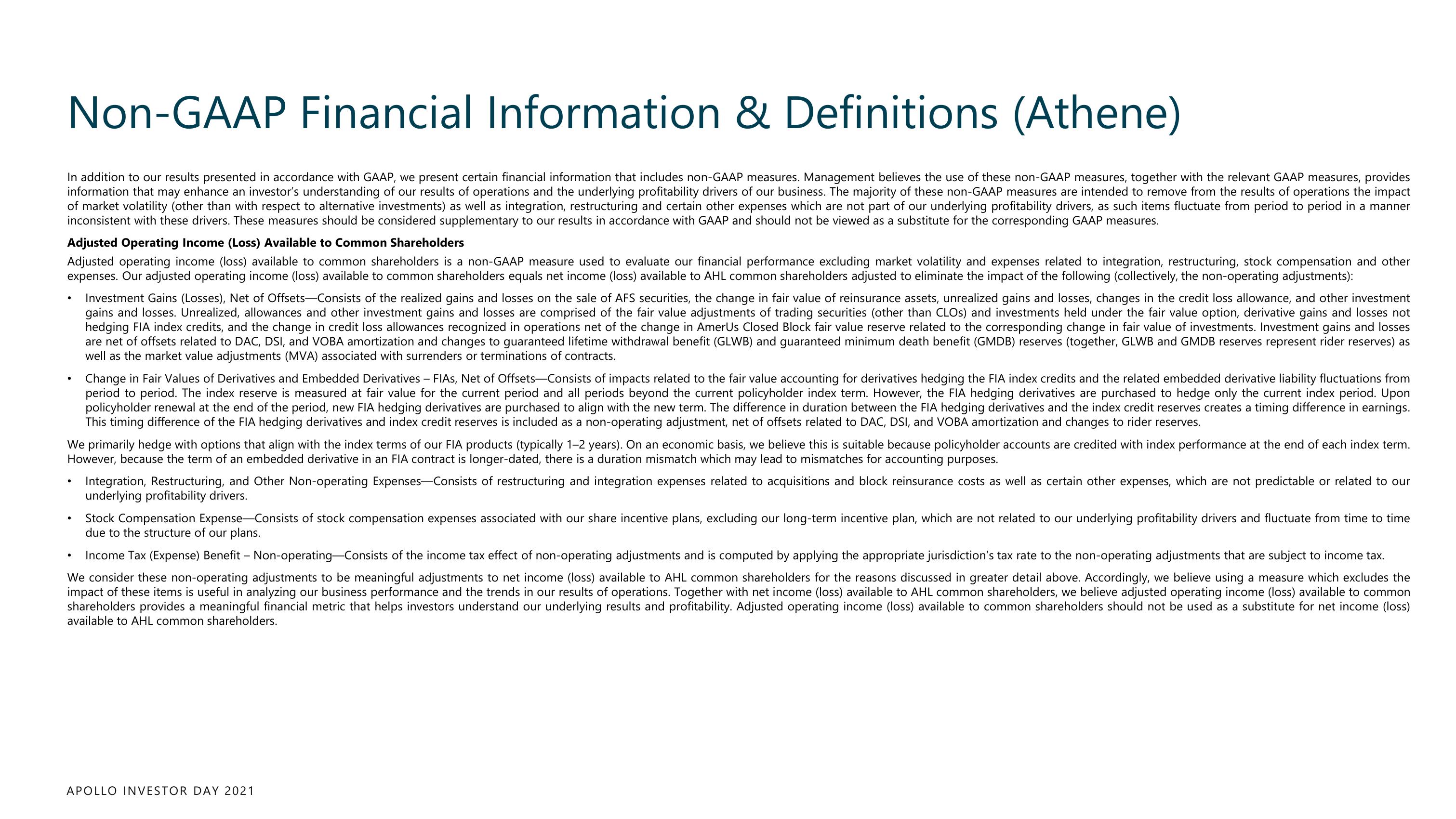Apollo Global Management Investor Day Presentation Deck
Non-GAAP Financial Information & Definitions (Athene)
In addition to our results presented in accordance with GAAP, we present certain financial information that includes non-GAAP measures. Management believes the use of these non-GAAP measures, together with the relevant GAAP measures, provides
information that may enhance an investor's understanding of our results of operations and the underlying profitability drivers of our business. The majority of these non-GAAP measures are intended to remove from the results of operations the impact
of market volatility (other than with respect to alternative investments) as well as integration, restructuring and certain other expenses which are not part of our underlying profitability drivers, as such items fluctuate from period to period in a manner
inconsistent with these drivers. These measures should be considered supplementary to our results in accordance with GAAP and should not be viewed as a substitute for the corresponding GAAP measures.
Adjusted Operating Income (Loss) Available to Common Shareholders
Adjusted operating income (loss) available to common shareholders is a non-GAAP measure used to evaluate our financial performance excluding market volatility and expenses related to integration, restructuring, stock compensation and other
expenses. Our adjusted operating income (loss) available to common shareholders equals net income (loss) available to AHL common shareholders adjusted to eliminate the impact of the following (collectively, the non-operating adjustments):
●
●
Investment Gains (Losses), Net of Offsets-Consists of the realized gains and losses on the sale of AFS securities, the change in fair value of reinsurance assets, unrealized gains and losses, changes in the credit loss allowance, and other investment
gains and losses. Unrealized, allowances and other investment gains and losses are comprised of the fair value adjustments of trading securities (other than CLOS) and investments held under the fair value option, derivative gains and losses not
hedging FIA index credits, and the change in credit loss allowances recognized in operations net of the change in AmerUs Closed Block fair value reserve related to the corresponding change in fair value of investments. Investment gains and losses
are net of offsets related to DAC, DSI, and VOBA amortization and changes to guaranteed lifetime withdrawal benefit (GLWB) and guaranteed minimum death benefit (GMDB) reserves (together, GLWB and GMDB reserves represent rider reserves) as
well as the market value adjustments (MVA) associated with surrenders or terminations of contracts.
●
Change in Fair Values of Derivatives and Embedded Derivatives - FIAS, Net of Offsets-Consists of impacts related to the fair value accounting for derivatives hedging the FIA index credits and the related embedded derivative liability fluctuations from
period to period. The index reserve is measured at fair value for the current period and all periods beyond the current policyholder index term. However, the FIA hedging derivatives are purchased to hedge only the current index period. Upon
policyholder renewal at the end of the period, new FIA hedging derivatives are purchased to align with the new term. The difference in duration between the FIA hedging derivatives and the index credit reserves creates a timing difference in earnings.
This timing difference of the FIA hedging derivatives and index credit reserves is included as a non-operating adjustment, net of offsets related to DAC, DSI, and VOBA amortization and changes to rider reserves.
We primarily hedge with options that align with the index terms of our FIA products (typically 1-2 years). On an economic basis, we believe this is suitable because policyholder accounts are credited with index performance at the end of each index term.
However, because the term of an embedded derivative in an FIA contract is longer-dated, there is a duration mismatch which may lead to mismatches for accounting purposes.
Integration, Restructuring, and Other Non-operating Expenses-Consists of restructuring and integration expenses related to acquisitions and block reinsurance costs as well as certain other expenses, which are not predictable or related to our
underlying profitability drivers.
Stock Compensation Expense-Consists of stock compensation expenses associated with our share incentive plans, excluding our long-term incentive plan, which are not related to our underlying profitability drivers and fluctuate from time to time
due to the structure of our plans.
Income Tax (Expense) Benefit - Non-operating-Consists of the income tax effect of non-operating adjustments and is computed by applying the appropriate jurisdiction's tax rate to the non-operating adjustments that are subject to income tax.
We consider these non-operating adjustments to be meaningful adjustments to net income (loss) available to AHL common shareholders for the reasons discussed in greater detail above. Accordingly, we believe using a measure which excludes the
impact of these items is useful in analyzing our business performance and the trends in our results of operations. Together with net income (loss) available to AHL common shareholders, we believe adjusted operating income (loss) available to common
shareholders provides a meaningful financial metric that helps investors understand our underlying results and profitability. Adjusted operating income (loss) available to common shareholders should not be used as a substitute for net income (loss)
available to AHL common shareholders.
APOLLO INVESTOR DAY 2021View entire presentation